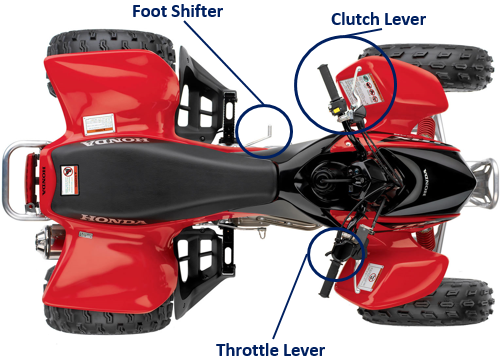Shedding the amount of weight on an ATV might sound more like an attempt to reduce the flying weight of an airplane.
Lets face it, ATVs are big and heavy and the idea of dropping a few pounds sounds a bit like wasted time and even wasted money when changing out parts. Wed agree if you use an ATV or Utility ATV for farm work, hunting or just having fun on trails.
But when racing ATVs either Motocross or off-road reducing significant weight offers a notable advantage over the competition. Keep in mind, though, that racing ATVs generally requires adding some parts like nerf bars and hand guards so trimming the load mostly gets your machine back to the original weight – the goal being to have a net difference as close to zero as possible. Of course, if youre a factory ATV Motocross rider like Thomas Brown you just might find 30 pounds to drop like his bone stock YFZ450R that left the factory at 405 pounds and competed at 375 pounds.
An ATVs size gives multiple options to decrease considerable weight and not just a few pounds. Both ATVs and Utility ATVs have a fervent fan base in racing and if you have an interest in racing or have raced with marginal results check out these suggestions for minimizing the load on your quad.

Best Options for Dropping ATV Weight
1. Wheels
Replacing the stock wheels with a high-end aftermarket brand probably ranks the highest in terms of shedding the most weight on your ATV. If you race MX or off-road you want better wheels anyway so replacing stock wheels not only gives you a weight advantage but better traction and overall better handling.
2. Remove the Parking Brake
You dont need the parking brake for a racing machine so remove it and save a few more pounds. You likely wont see any serious racers riding an ATV with the parking brake installed.
3. Trim the Fat
A little bit here and there can add up and if done right you can more than break even on weight gain versus loss after adding the necessary parts to realistically compete in Motocross:
- Replace the front coil shock with an air shock
- Replace the lead acid battery with a lithium battery
- Replace exhaust with a lighter aftermarket version
- Replace airbox with a lighter aftermarket version
- Run Motocross tires – when racing MX otherwise use the appropriate off-road version
All these changes also impact an ATVs overall performance so with the weight savings you get a faster, more responsive machine thanks to the upgrades.
More Ideas to Reduce Quad Weight
After these suggestions removing much more weight proves a bit difficult. Lots of tricks of the trade exist like drilling holes in bolts and washers but spending the time to do this for probably less than a pound makes little sense. Plus, you impact the integrity of the very parts that keep your ATV together.
So, now focus on what you dont need. Cutting fenders not only helps with visibility but helps a little with weight and replacing the seat with one that uses lightweight foam subtracts maybe another pound or two.
The gas tank in an ATV holds between two and a half and three gallons. When racing in the amateur ranks you wont run a full Moto like the pros so figure out how much gas you need and run less than a full tank. Each gallon of gas weighs six pounds – if you only need a gallon and a half you can save six to nine pounds of weight. This trick only works in Motocross, dont bother in off-road or other hare scrambles.
Lastly, focus on your weight. On race day, watch how much you eat and hit the bathroom before gate drop. Eliminating your own load and not riding with a bomb of food in your stomach keeps you comfortable and lightweight.
How-To Shift ATV / Dirt Bike 10 Most Frequently Asked Questions! From 500k View Tutorial!
FAQ
When riding up a hill your weight shift should be toward the rear of the ATV?
How do you shift a quad on an ATV?
Before you begin, make sure your quad is in neutral. Neutral is found between the first and second gears on most ATVs. You need to hold the clutch and click down with the foot shifter until you hit first gear. Then you need to click up to hit neutral. Once you’re in neutral, pull the clutch lever.
How do you turn a 4 wheeler?
Upon exiting the turn, slightly elevate your speed. Depending on whether your four-wheeler has a solid rear axle or a locked differential, leaning into turns will slightly differ for you. But either way, it is recommended to shift your position forward and outward before leaning into a slow turn and to move inward and forward before a fast turn.
How to shift semi-automatic ATV?
Before you learn how to shift semi-automatic, you’ll first need to understand how a semi-automatic ATV work. Now, in manual ATVs just as the name suggests, the sifting of gears is done manually. This involves letting off the throttle and pulling the clutch lever before shifting through the gears using the foot shifter.
How do you downshift an ATV?
Downshift into lower gears as you slow down your ATV. When you’re decreasing your speed, you also need to shift back into lower gears. Hold the clutch with your left hand and press down on the gear shift lever with your left foot, then release the clutch. You’ll feel the lever click down as you downshift.
